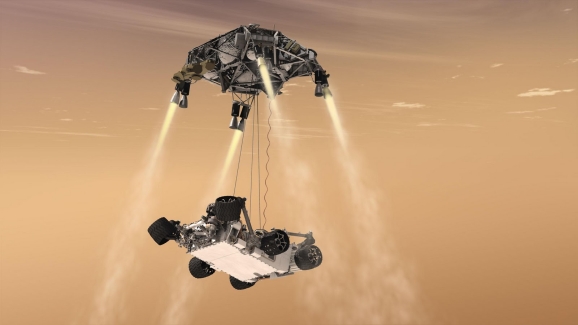Promoting Curiosity, NASA’s Big Gamble
This article is more than 2 years old

It seems like you can’t go two minutes on the internet these days without hearing about the impending landing of the Curiosity rover on Mars. NASA has outdone themselves with a public relations and media machine that has covered this unmanned science mission in more ways and with more frequency than any other robotic mission before it. So with videogames, Star Trek actor-narrated videos, and public interaction with the project every step of the way through its manufacture and launch, you have to ask the question, what happens if the rover crashes?
You’ve heard about the “seven minutes of terror,” you’ve seen the animations, you know just how complicated the landing of the Curiosity rover will be. You also may or may not know that when it comes to landing spacecraft on Mars, Earth has about a 40% success rate at not adding new craters to the red planet’s surface. Sure, we’ve gotten better at designing super-complicated craft and refining our mission strategies over the years, but there is still a large margin for error to consider. You’d think that with the odds so stacked against success, NASA wouldn’t be tooting its horn so much, but then again it may not have much of a choice.

In 2013 President Obama’s budget proposal will take a $309 million chunk out NASA’s Planetary Science division. Out of that $309 million, over $130 million will come directly out of the Mars exploration program. With a cut like that, we may not see a follow up to the $2.5 billion Curiosity anytime soon. So far, after dropping out of the ESA’s ExoMars mission, the only thing that NASA has on the books for the red planet is the Maven mission launching next year to study Mars’ atmosphere from orbit. The sad fact is, the money was bled from NASA’s successful planetary science program to continue funding the James Webb Space Telescope (JWST) and the Space Launch System (SLS). While the Curiosity rover itself went over budget in typical governmental fashion, the JWST has gone so wildly over budget that its future has been thrown into doubt several times, and the SLS, if it follows the lead of its underfunded Constellation program predecessor, may well be doomed before it even gets halfway through the design phase.
With the withering budget, it’s looking like NASA has started to step up its PR game out of a sense of self-preservation. If the Curiosity rover lands successfully, then it’s a safe bet that they’re hoping people’s interest in science and space exploration will reignite and hopefully press their elected officials to increase funding for NASA . This may not be the most realistic of expectations, because let’s face it: robots are not as exciting as people. Sure the tech is cool and the science is great, but a successful landing of Curiosity on Mars will not have the impact of another Moon landing, no matter how much money NASA puts into promoting it. Even though people are being reminded to watch the landing coverage of the craft on NASA TV, the false expectation that the media machine has put into people’s minds that they will witness the landing might hurt NASA more than it helps. After months of build up, spectators are likely to see nothing more than a clapping mission control room as a climax to Curiosity’s journey to Mars. Space nerds like myself may enjoy the commentary and lead-up to the landing, but I can also understand that anyone who has just gotten into this from the coverage it has received might expect more from the landing and wind up disappointed at the lack of neat video.

If Curiosity fails, however, and all of that money and effort are wasted, we might be looking at the final nail in the coffin of a program that has been largely successful. With $2.5 billion scattered across the surface of Mars, it might be hard to convince anyone to give NASA more money on yet another Mars rover, or for that matter anything of appreciable size. In a society that punishes failure like our does, the long and successful history of the planetary science program may be the last thing on people’s minds if a costly science laboratory ends up a scrap heap in the current economic environment.
Time will tell if NASA’s social and digital media investment will pay off, but until then make sure to temper your expectations with reality. Oh, and here’s a new Curiosity video…












